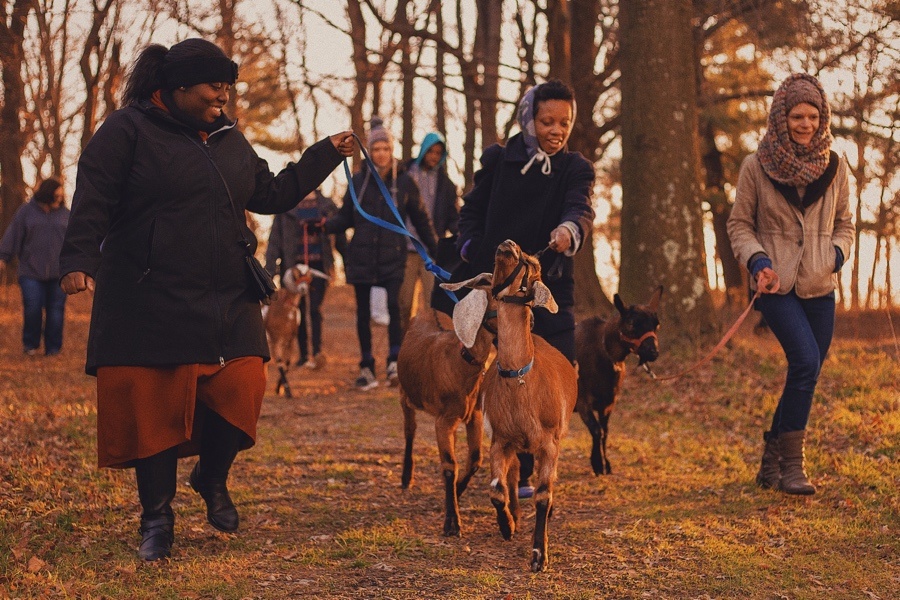You Can Take a Walk With Goats for Free, and It’s As Great as It Sounds
We joined the Philly Goat Project for one of the nonprofit's bimonthly community walks.

The Philly Goat Project offers goat therapy, goat yoga, and community walks with goats on a regular basis. / Photograph by Jerome Eno
“Are you here for the goats?” Karen Krivit calls out.
Strangely, I am indeed in Northwest Philly at the Awbury Arboretum (and metaphorically VERY here) for the goats. They’re owned by the Philly Goat Project, a nonprofit based at the former Cope family estate that offers goat-assisted therapy, goat yoga, goat grazing, and about twice-a-month community walks with, yes, goats.
The latter is what I’m about to embark on on a sunny afternoon in late September. As I get out of my car, I see a crew of about 15 brown, white, and black goats standing on the sidewalk with curious looks on their pointed faces. A diverse group of kids, teenagers, and adults is holding them on leashes to make sure they don’t run out into the traffic surrounding the arboretum.
I scramble to join the group. Krivit, a former social worker and now the director of the Philly Goat Project, hands me the leash for a goat, a spindly baby Nubian named Joy. She is tiny, just a few months old, and clearly eager to explore the brand-new world around her. Within a couple feet, her bridle/muzzle apparatus falls off, and Krivit pulls her aside to wrestle it back on. It doesn’t take long for the other goats to recognize one of their herd is missing, and they stop and start bleating in harmony, looking back to determine where she is. Joy returns their call, straining to get back to her family and making me feel a bit like the Grinch — my heart grew three sizes that day.
We wrap around the property and end up at the private back entrance of AdventureWoods, a learning playground for kids that’s used for camps in the summer. Turns out it’s a playground for goats, too; there are stumps and logs everywhere, and the larger, stronger Nigerian Dwarf goats — Krivit has 14 goats who come from two different herds, the Nubians and the Nigerian dwarves — in particular are blissfully jumping on the sawed-off trees. Their antics make everyone more gleeful but also forced to pay more attention to their surroundings. “I work with so many people who are so out of touch with their senses and nature and outside,” Krivit had told me on the phone a few weeks earlier. “We’re going into two generations now that are electronic generations. People don’t know how to play outside. The goats are ambassadors to that.”
Unlike most of the other goats, Joy is more interested in the grass, leaves, and plants around her. She halts abruptly, again and again, to rip up some greenery for her next snack. I keep yanking her head up until Krivit tells me it’s fine — they’re goats, they graze. (The Philly Goat Project actually have a side hustle clearing invasive species in the area.) I feel a little silly. I’ve been treating Joy more like a naughty dog who shouldn’t be eating random items when eating vegetation is literally what she’s been bred to do.
As we walk along, I survey the other goats. Some are big and docile, ambling along, their large rears waving back and forth. Others are precocious. Clementine, one of the Nigerian dwarves, keeps head butting Joy to exert her dominance, even though poor little Joy is the last thing from an instigator. I screech at Clementine, having already grown protective of my runt goat. I’ll keep you safe from bullies, I think to myself.
These kinds of strong feelings tie into why animals in general are good therapy tools. “People develop relationships with animals in ways that are different from other people,” Krivit had said. “I have some kids who just stand there with the goats and pet their ears for half an hour, and the goats have a sense that they need that.” Compared to more traditional therapy animals, goats, Krivit says, goats aren’t as big as horses, which makes them easier to manage, and unlike dogs, they don’t drool, bark, or have sharp teeth. Translation: Kids aren’t as afraid of them.
To that end, Krivit recently kicked off a program at three K-8 schools that border Awbury to offer students an opportunity to work with the goats once a month and is in the process of partnering with the Fairmount Parks system to provide walks in locations other than the arboretum. She hopes these will extend the reach of the Philly Goat Project to more populations for whom wellness is often costly and prohibitive.
As we get closer to the barn, I’m reluctant to hand Joy back to Krivit and her daughter, Lily Sage, the assistant director of the Philly Goat Project. It means my stroll through forests and meadows is over, and I have to think about the tasks I should probably check off my to-do list. But I feel lighter, like I’m simultaneously calmer and have more energy to take on the obligations that lie ahead. Nothing is going to get my goat today.


